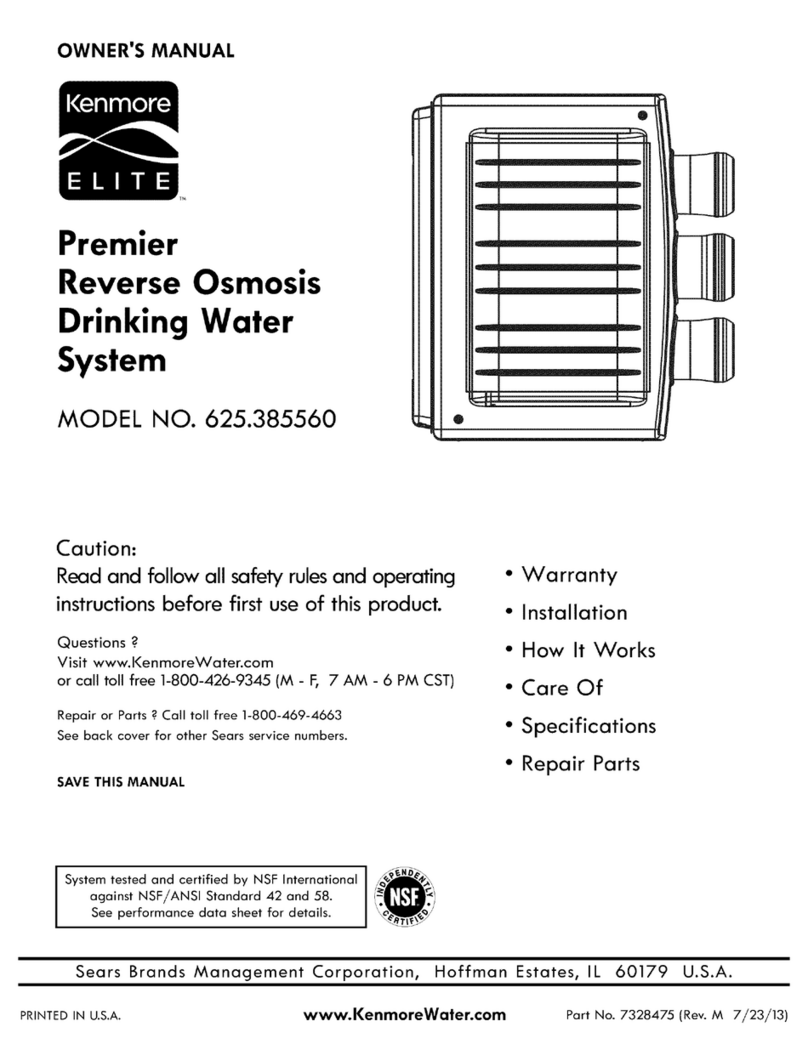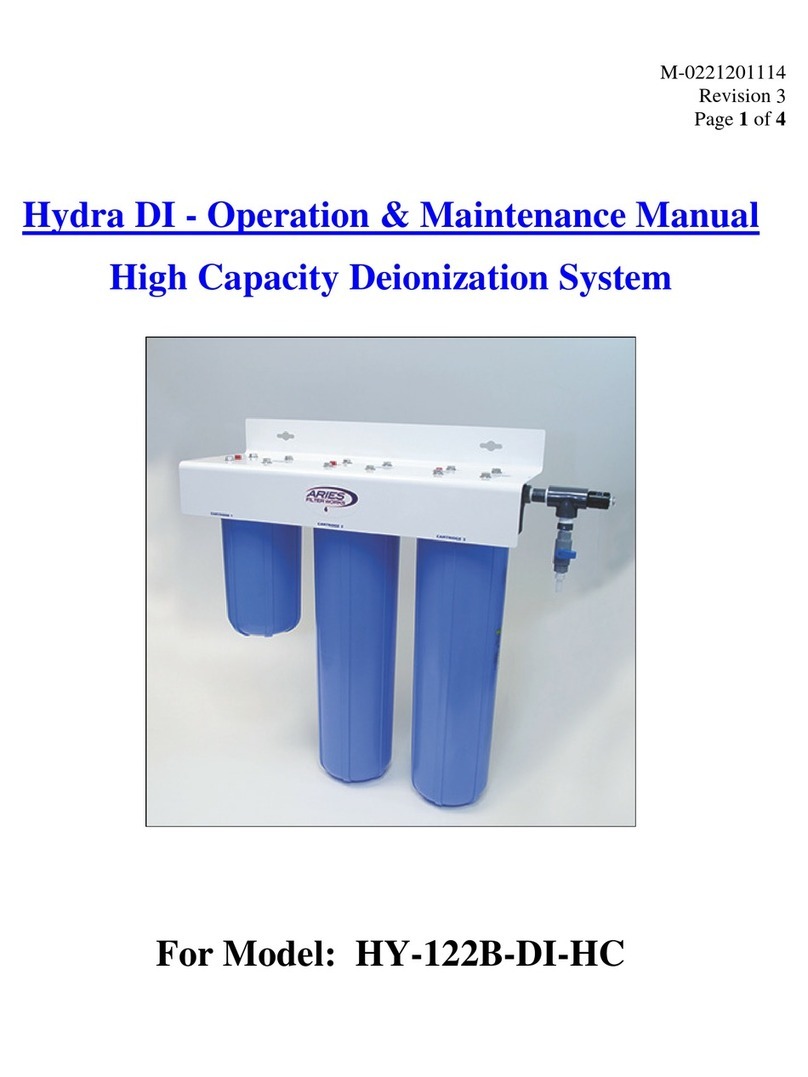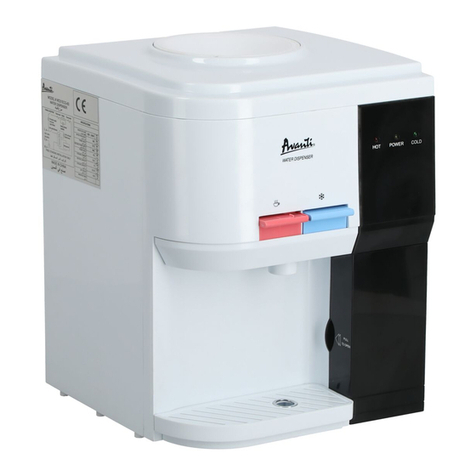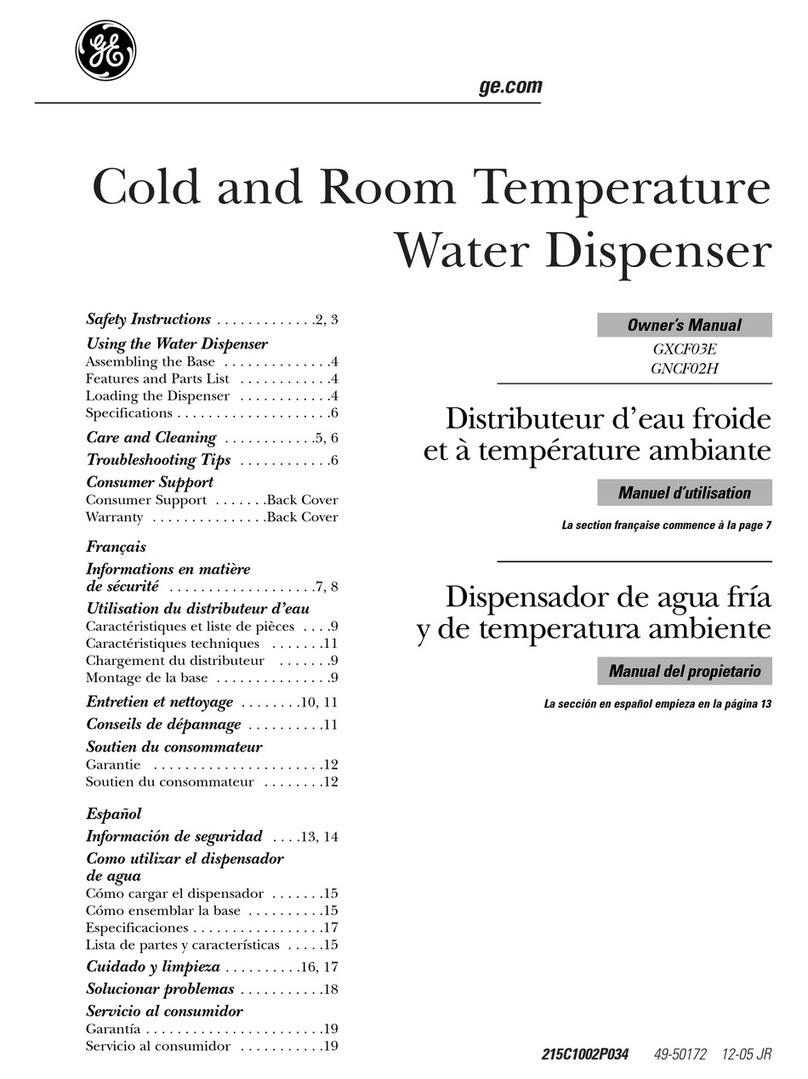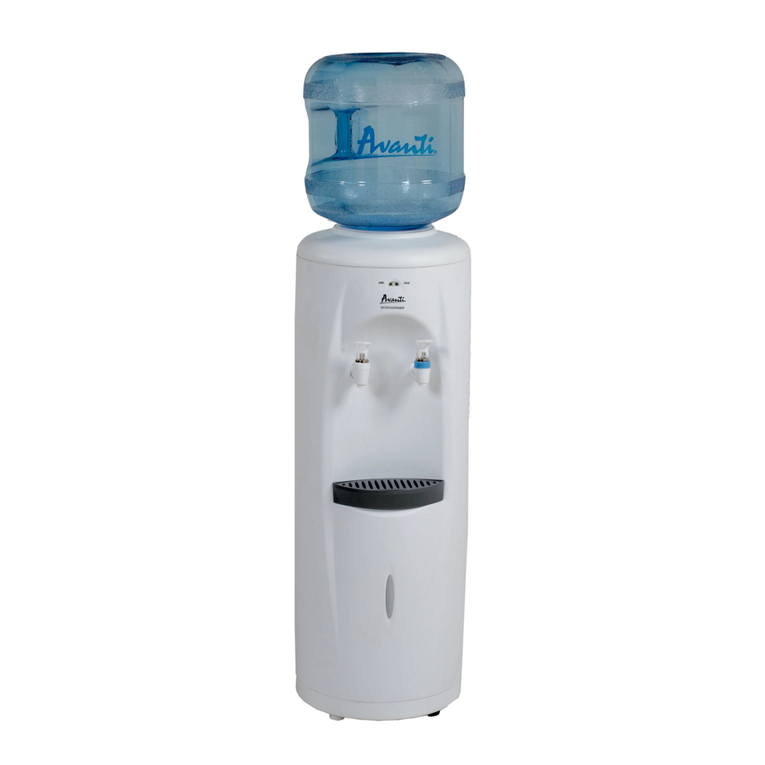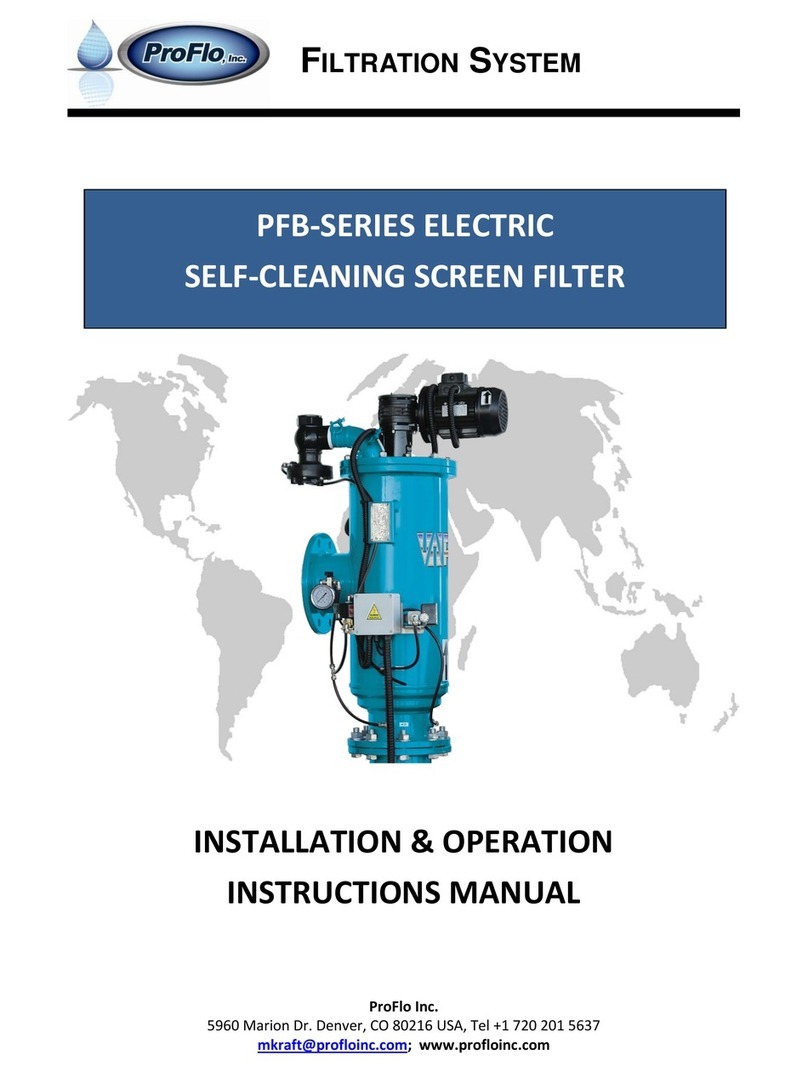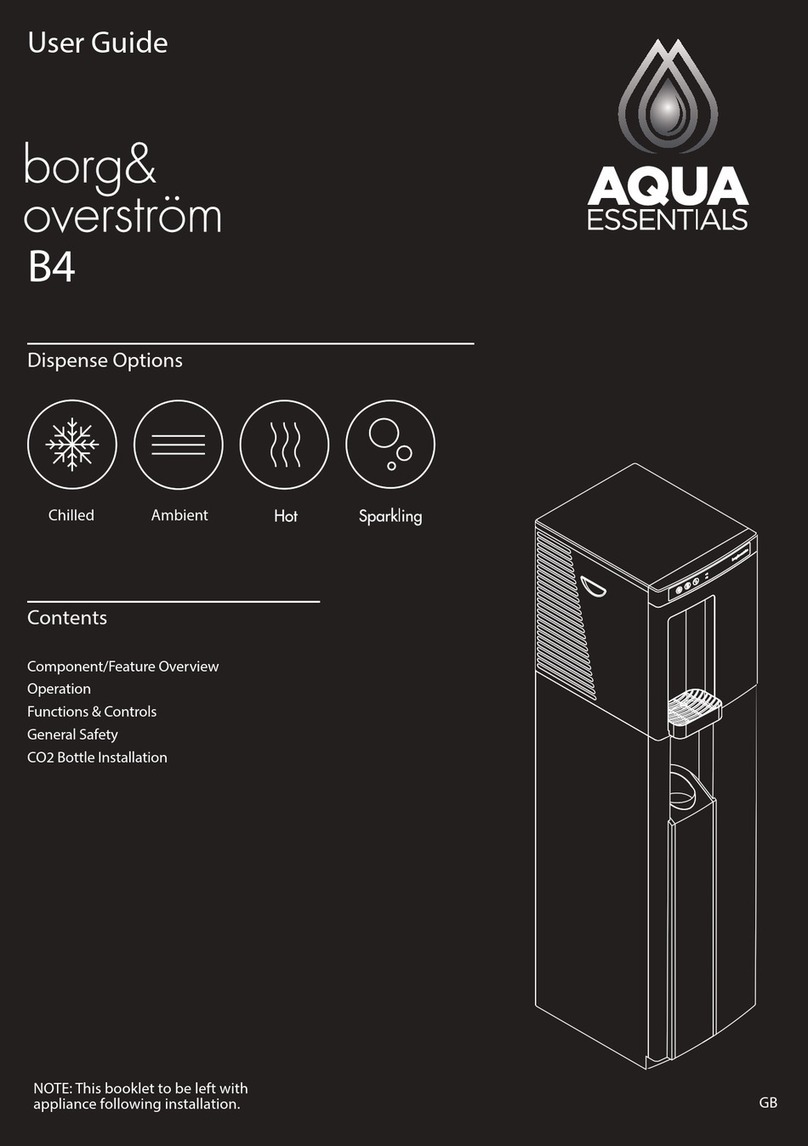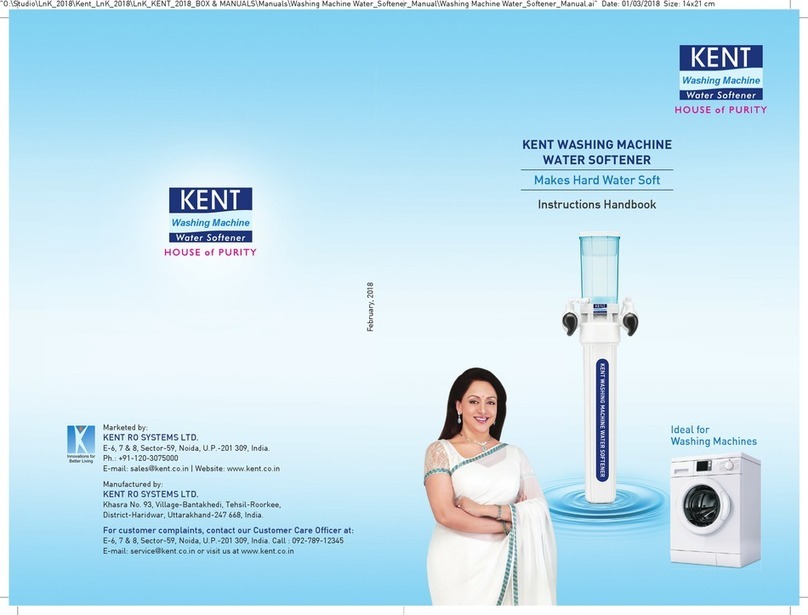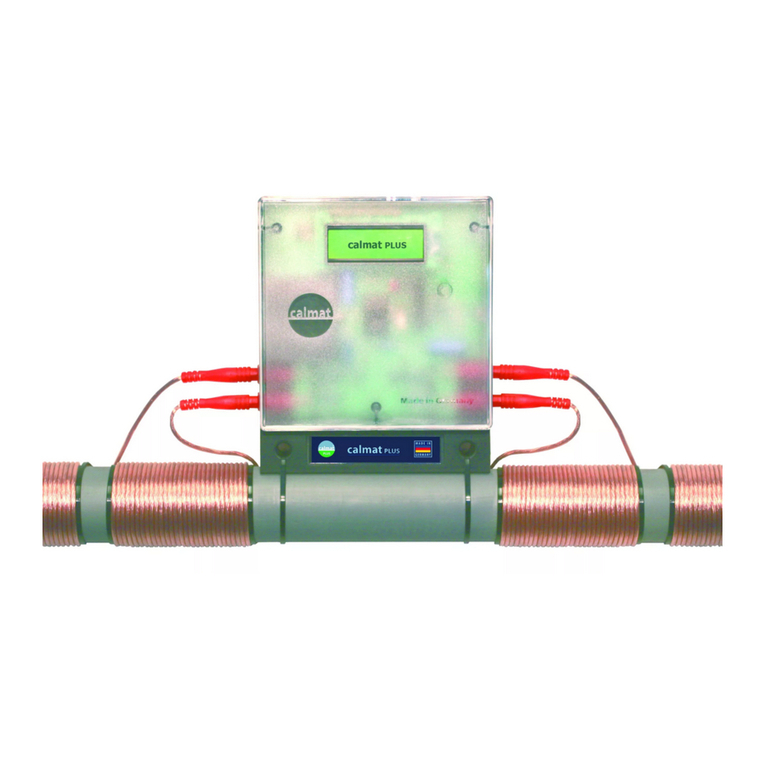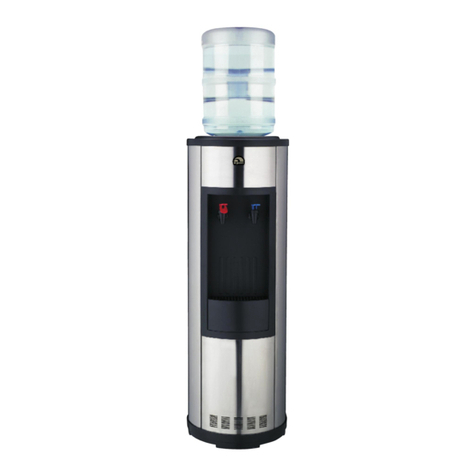Hidro-Water KOBE WS1CI UF Instruction Manual

2 3
MA-EN-DESCALCIFICADOR KOBE (USR) UF-3004-XX JD18V01 MA-EN-DESCALCIFICADOR KOBE (USR) UF-3004-XX JD18V01
INDEX
1.- INTRODUCTION ................................................................................................4
1.1.- Operating information - Theory ..........................................................................4
1.1.1 Service phase..............................................................................................4
1.1.2 Regeneration phase ...................................................................................4
2.- TECHNICAL DATA ............................................................................................5
2.1.- Operating pressure ..............................................................................................5
2.2.- Operating temperatures......................................................................................5
2.3.- Component materials ..........................................................................................5
2.4.- Water alterations..................................................................................................5
2.5.- Capacity................................................................................................................5
2.6.- Dimensions...........................................................................................................6
2.7.- Characteristics .....................................................................................................6
3.- INSTALLATION REQUIREMENTS....................................................................7
4.- SAFETY MEASURES........................................................................................7
5.- INSTALLATION & CONNECTIONS...................................................................7
5.1.- Unpacking .............................................................................................................7
5.2.- Diagram ................................................................................................................8
5.3.- Connecting the system to the water intake.......................................................9
5.3.1 Inlets and Outlets.......................................................................................9
5.3.2 Hydraulic connections level....................................................................10
5.3.3 By-Pass.....................................................................................................10
5.3.4 Connecting the inlet and outlet line.......................................................12
5.3.5 Connecting the drainage line (drain)......................................................12
5.3.6 Connecting the overflow line..................................................................13
5.3.7 Connecting the brine line........................................................................13
5.4.- Electrical connection.........................................................................................13
6.- PROGRAMMING - USER LEVEL / INSTALLER.............................................14
6.1.- Button functionality ...........................................................................................14
6.2.- Setting the time..................................................................................................15
6.3.- Service screen ...................................................................................................15
6.4.- Programming......................................................................................................16
6.4.1 Inlet hardness...........................................................................................16
6.4.2 Outlet hardness .......................................................................................16
6.4.3 Forced regeneration ................................................................................16
6.4.4 Regeneration time ...................................................................................16
7.- INSTALLATION CHECK LIST .........................................................................17
8.- START UP........................................................................................................17
8.1.- Bleeding air.........................................................................................................17
8.2.- Fill verification....................................................................................................18
8.3.- Suction verification............................................................................................19
8.3.1 Suction ......................................................................................................19
8.3.2 Filling ........................................................................................................19
8.4.- Start up ...............................................................................................................19
8.5.- Residual hardness setting ................................................................................20
8.6.- Adding salt..........................................................................................................20
8.7.- Checking the flow meter....................................................................................21
9.- CLEANING.......................................................................................................22
10.- MANUAL REGENERATION ..........................................................................22
11.- START-UP CHECK LIST................................................................................22
12.- MAINTENANCE GUIDE AND TROUBLESHOOTING ..................................23
12.1.- Periodic checks ................................................................................................23
12.2.- Problems, causes and possible solutions.....................................................24
13.- PARTS & ACCESSORIES..............................................................................26
13.1.- Electromechanics.............................................................................................26
13.2.- Hydraulic body .................................................................................................27
13.3.- Injector set........................................................................................................28
13.4.- Suction set........................................................................................................29
13.5.- Drainage set......................................................................................................30
13.6.- Flowmeter and residual mixing valve.............................................................31
13.7.- System ...............................................................................................................32
13.8.- Common accessories......................................................................................34
14.- GUARANTEE.................................................................................................35

4 5
MA-EN-DESCALCIFICADOR KOBE (USR) UF-3004-XX JD18V01 MA-EN-DESCALCIFICADOR KOBE (USR) UF-3004-XX JD18V01
So that these systems work correctly, they must operate within a certain pressure range, along them
to work correctly and safely. This working pressure is as follows:
• Minimum pressure: 2,5 kg/cm2.
• Maximum pressure: 6 kg/cm2.
If the pressure is below 2.5 kg/cm2, some cycles wouldn’t work properly and/or have an
appropriate water supply. In that case, a pump system should be installed to assure the necessary
ow and pressure.
If the pressure is over 6 kg/cm2it would be dangerous for the system as it would deteriorate
or break down. Therefore, a pressure reducer should be installed.
2.1.- Operating pressure
2.3.- Component materials
2.2.- Operating temperatures
2.4.- Water alterations
2.5.- Capacity
Just like any device, your new Kobe has optimal performance within its Operating Range:
• Valve: Strengthened GF Noryl.
• Bottle tank: Polyethylene Coated with GF reinforced polyester.
• Housing cabinet: Made from HDPE.
• Cationic descaling resin, Manufactured with polymers of high technical qualication,
regenerable sodium form (NaCI).
• The system should NOT be supplied with hot water (Tª < 36°C).
• Room temperature should be between 4 - 43 °C.
• By going through the softener, the water’s sodium level is increased.
• By going through the softener, the water’s calcium and magnesium levels are reduced.
• By going through the softener, the water’s pH & chlorine may be reduced.
• Maximum operating ow:
○KOBE 14 = 0.5 m3/h + mix
○KOBE 22 = 0.77 m³/h + mix
○KOBE 35 = 1.2 m³/h + mix
2.- TECHNICAL DATA
1.- INTRODUCTION
Once the resin bed has retained the total amount of Calcium and Magnesium ions (water
hardness) that they are capable of retaining, the bed must be regenerated to start a new work
cycle.
The regeneration process consists of several stages with the finality of regenerating the
resin bed and preparing it for a new work cycle.
The Kobe series softeners automatically start and carry out the alternation between service
and regeneration phases without the user having to manipulate the machine.
Hidro-Water S.L. wants to thank you for purchasing your new Kobe system. We hope you
enjoy the benets of having softened water. Among other things, this means:
• Less consumption of cleaning products (soap, fabric softener, anti-limescale products…).
• Softer skin, silkier hair (more comfortable showers and shaves, causing less irritation).
• Clothes last longer as well as their colours.
• Savings on your electric bill (water heats up quicker).
In this manual, you can nd the steps to follow for the Kobe Series softener system’s
installation, start-up and maintenance.
Keep this manual safe for future reference and if you have any query or doubt, please contact
your distributer’s Technical Support Department. (See stamp on back of manual).
The softening process in your Kobe system will be carried out through an ionic
exchange process.
To do so, ionic exchange resins are used. They have the chemical capacity to capture
water hardness, Calcium (Ca) and Magnesium (Mg) ions and eliminate them from the
treated water. At the same time that the Calcium and Magnesium ions are captured by the
resin a Sodium (Na) ion is released, which due to its chemical characteristics forms salt
particles with a solubility much higher thus avoiding problems associated with hardness.
During the treatment process – service cycle – the water enters the valve through the inlet
connection, ows from the upper part of the bottle, through the resin bed in a descending manner
which is how the ionic Exchange takes place (softening). The treated water is send through the
outlet connection to the supply line.
1.1.- Operating information - Theory
1.1.1 Service phase
1.1.2 Regeneration phase

6 7
C
B
A
MA-EN-DESCALCIFICADOR KOBE (USR) UF-3004-XX JD18V01 MA-EN-DESCALCIFICADOR KOBE (USR) UF-3004-XX JD18V01
• Before starting the installation, fully read through this manual and have the tools and
materials you are going to need to do so at hand.
• Water softeners should be installed and connected to inlet, outlet and drainage pipes
according to the producer’s instructions and complying with the current regulations
regarding low voltage electrical installations and hydraulic installations.
When unpacking, we have to bear in mind the following:
• That the system is in perfect condition and hasn’t received any knocks during transportation.
• Do not turn the package upside down or place it on irregular or sharp surfaces.
• That the accessories included are the correct ones and the ones necessary.
5.1.- Unpacking
1It must have the relevant protection systems according to RBT (low voltage regulation) but not be interrupted by any switch or have
motors connected to the same line.
2As close as possible to the equipment and at least 30 cm below an overow outlet. For other types of installations, consult the technical
oce rst.
3.- INSTALLATION REQUIREMENTS
4.- SAFETY MEASURES
5.- INSTALLATION & CONNECTIONS
• Installation must be carried out by a qualied technician.
• Make sure the main water supply is turned o before starting the installation.
• Always install an original and/or external bypass system.
• An uninterruptible power outlet is necessary1230Vac - 50Hz and a drain near2the system.
• After nishing the installation and when starting up, check and repair any leaks if necessary.
Choosing the location of instalment
• The adequate place where you choose to put the system must have easy access to access
the system and also to ll up the salt tank.
• The system must be placed on a at surface, protected from direct sunlight, rain and humidity.
• The system (including the overow and drainage lines) must be placed out of freezing
temperatures and those that are over 43ºC.
• The system mustn’t be installed near acid nor vapours, or be exposed to products derived
from petroleum, to avoid the risks of deagration and explosion.
• Do not install any unit between the outlet of the softener and the inlet of the water heater within
less than 3m of piping. If there is a heating element in the system, a non-return valve must be
installed to prevent the hot water damaging the water softener.
2.6.- Dimensions
2.7.- Characteristics
• Automatic compact softeners to remove hardness via interchangeable ionic resins.
• Low water and salt consumption.
• Volumetric CLACK WS1CI UF valve, digital programmer and delayed or instant counter-ow
regeneration
• Housing cabinet made of polythene.
• Bottle tank made of wound Polythene with glass-bre reinforced polyester (GFRP).
• Regeneration through consumption.
• Programmable forced regeneration frequency.
• Integrated hardness mixer.
• Turbine to control the volume of treated water.
• 1” connection.
• Bypass option and 1” 90º elbow joint adapter.
• Security salt buoy included.
• Resin loading for food use, high capacity for high performance
• Voltage: 230V-15V DC 50Hz.
Code
System Packaging
Dimensions (mm) Weight
(Kg)
Dimensions (mm) Logístics (Units)
A B C A B C Pallet 20ft
Cont.
40ft
Cont.
UF-3004-02 = UF-3004-07 351 523 705 24 370 540 760 5 90 220
UF-3004-04 = UF-3004-08 351 523 1134 33 370 540 1160 5 45 110
UF-3004-05 = UF-3004-09 351 523 1134 45 370 540 1160 5 45 110
Code Model Work ow (m3/h) Salt consumption
(Kg/reg.) By-pass
UF-3004-02 CRV 14L 0,5 1,4 NO
UF-3004-04 CRV 22L 0,7 2,2 NO
UF-3004-05 CRV 35L 1,2 3,5 NO
UF-3004-07 CRV 14L 0,5 1,4 YES
UF-3004-08 CRV 22L 0,7 2,2 YES
UF-3004-09 CRV 35L 1,2 3,5 YES

89
MA-EN-DESCALCIFICADOR KOBE (USR) UF-3004-XX JD18V01 MA-EN-DESCALCIFICADOR KOBE (USR) UF-3004-XX JD18V01
1. Drainage
2. Suction / Brine
3. Water to be treated inlet
4. Treated water outlet
• This system is designed to be connected to 1” tubing.
• The softener’s valve’s inlet and outlet connection are indicated by their corresponding
direction arrow.
• The salt tank’s drainage and overow connection lead to the drain. Both connections will be
independent and have a direct discharge to avoid anything returning.
• The inlet and outlet connections to the pipeline are carried out using exible tubes which
must comply with current regulations to avoid tension and possible breakages of the valve’s
Noryl® head.
• It is recommended to previously install a clarifying valve to protect the valve, the resin and
the installation itself from suspended matter, impurities, sand, etc. which are common in the
distribution network, drilling waters, either on the surface or underground.
5.3.- Connecting the system to the water intake
5.3.1 Inlets and Outlets
Accessories:
1. Manual
2. Transformer
3. Inlet/outlet connector set
4. Drainage connector
5. Bypass (optional)
5.2.- Diagram
Typical diagram of a domestic installation and the location of its components.
The company HIDRO-WATER, S.L.U. will not be held responsible if the
installer or user fails to obey the guidance found in this manual
Bypass system is standard on
the following models:
UF-3004-07 / UF-3004-08 / UF-3004-09
Optional on the rest of models View
Whitout By-pass CLACK
With By-pass CLACK
Id Description
1 Inlet of water to be treated
2Inlet lter valve
3 Bypass lter valve
4 Outlet lter valve
5Sediments lter
6 Kobe softener
7 General bypass valve
8Softener outlet valve
9 Drainage line
10 Overow line
11 Drain
12 Treated water outlet

10 11
75 mm
560 mm
975 mm
360 mm
780 mm
MA-EN-DESCALCIFICADOR KOBE (USR) UF-3004-XX JD18V01 MA-EN-DESCALCIFICADOR KOBE (USR) UF-3004-XX JD18V01
5.3.2 Hydraulic connections level
The distance between
the centre of the inlet and
outlet connections on
CLACK WS1CI valves
Height from the oor to
the centre of: inlet / outlet
and overow
KOBE 14L Model
Height from the oor to
the centre of: inlet / outlet
and overow
KOBE 22 y 35L Model
To ease maintenance or repairs without cutting the water supply, a bypass system must
be installed. The most common bypass systems are using ball valves or the bypass for Clack
WS1CI valves.
Installing Kobe’s original bypass:
Among the accessories that come with the system, you can nd the Kobe system’s original
bypass and the system’s inlet and outlet connections (items 5 and 3 on the accessories list)
which are located in the salt tank as mentioned in the unpacking the system section (5.1).
System installation is very straightforward and doesn’t require any tools.
a. Prepare all of the pieces that you’re going to need.
b. In the slot that’s closest to the thread, we must place the supporting washer (white) on the
inlet/outlet connector.
c. In the slot that’s furthest from the thread, we must place the O-ring seal (black) on the
inlet/outlet connector.
d. Insert the connector on the bypass’s inlet or outlet (on the side that has a male thread)
e. Fix it into place by screwing on the fastening nut included in the inlet – outlet connectors.
f. Repeat steps b, c, d, & e for the other connector.
g. Insert the opposite end of the bypass (part with seals) in the rear part of the valve (inlet
and outlet)
h. Fix it into place using the two fastening nuts included in the bypass.
i. Now the bypass is fully set up.
5.3.3 By-Pass
CLACK By-Pass
BYPASS:
Direct water supply
without going through
the softene
OPERATIONAL:
Water goes through the
softener
External By-Pass
Fig. a
Fig. f Fig. g Fig. h Fig. i
Fig. b Fig. c Fig. d Fig. e
Lubricate the O-ring seals once placed on with any type of grease. It will
allow the parts to be inserted more easily.

12 13
MA-EN-DESCALCIFICADOR KOBE (USR) UF-3004-XX JD18V01 MA-EN-DESCALCIFICADOR KOBE (USR) UF-3004-XX JD18V01
As mentioned in section 5.3., the inlet and outlet connections must be
carried out using a exible tube to connect the xed installation to the
softener. Although it isn’t necessary as the system has its own bypass
system, it is recommended to make an external bypass system to be
able to cut o all of the treatment systems (normally the softener and
prelter) from the water installation if necessary.
Hidro-Water recommends the use of female-female or female-male
exible hoses depending on what is required for the current installation.
That way, we isolate the transmission of possible vibrations between the
installation and the system.
Make sure the female connection has its corresponding rubber washer
and the male (is so) is correctly sealed (you can use a paste, tape, Teon®
thread sealant or whatever you prefer) to avoid water leaks.
The system should be placed as close to a drain as possible. The ideal connection that is
recommended by the manufacturer is directly above and no more than 3 meters away from the
draining point. The drainage line connection will be made with a 13mm (interior diameter) exible
tube (we recommend a 17x13 transparent PVC exible tube. To do so, the nut and the tube
support must be inserted (item number 4 of the accessories shown in section 5.1 ‘unpacking’),
through one end of the inner 13mm exible tube, and screw it into the drain outlet valve. If you
prefer to use other another type of tube, the thread of the drain outlet is a ¾” male thread.
The drainage level will be below the softener’s outlet valve. If not, please contact our
technical department.
The brine tank’s safety overow leads the overow to
the drain instead of being spilt all over the oor. To connect
the overow line, connect a tube or hose with an interior
diameter or 13mm and lead it to the drain (we recommend
a 17x13 transparent PVC exible tube).
Always leave an air space between the drainage tube
and the general drain to avoid the possibility of anything
coming back up the drain. This could aect the systems
normal functionality.
5.3.4 Connecting the inlet and outlet line
5.3.5 Connecting the drainage line (drain)
5.3.6 Connecting the overflow line
The softener’s drainage connection and the brine tank’s overow line lead to the
drain. Both lines should be independent and should not be connected. Both lines
must have a direct discharge to avoid anything coming back up.
Do not connect the overflow line to the control unit’s drainage line. The
overflow line must be a direct line and separate to the drainage line leading
to the general drain.
The head must be connected to the brine valve located in
the salt tank to a polythene tube using two QF connectors
(quick connection ends). This tube is factory installed,
but due to its relevance in the correct functioning of
the equipment, we recommend checking the correct
connection at both ends. The tube must be inserted all
the way; Retract it slightly to conrm that it is correctly
connected.
5.3.7 Connecting the brine line
You must assure that all of the accessories and couplings are correctly connected to avoid
taking in air.
Once the previous connections have been made, the water softener’s programmer valve
must be connected to the 230V ac 50Hz power supply, using the transformer supplied with it.
The electrical installation of the equipment is carried out following the appropriate electrical
installation regulations. The appropriate protection devices (a miniature circuit breaker (MCB)
and dierential) must be provided in the supply line.
5.4.- Electrical connection
The equipment will be connected to an independent lighting line powered 24 hours
a day, NEVER on any line connected to motors.

14 15
SET TIME
TIME
CAPACITY REMAINING
M3
TIME
L
MIN
MA-EN-DESCALCIFICADOR KOBE (USR) UF-3004-XX JD18V01 MA-EN-DESCALCIFICADOR KOBE (USR) UF-3004-XX JD18V01
The transformer comes pre-installed from the factory. Check that it is correctly connected to
its connector as shown in the images and plug it into the mains.
This process can be repeated whenever necessary just by starting from the service screen by
pressing at any moment.
Once the correct hydraulic installation has been checked and the power cable is connected to the
230V ac - 50 Hz mains, in a socket that is not controlled by a switch, the valve will be programmed.
When the equipment is electrically powered, the installed software version will appear on the screen.
The valve motor will move to conrm the position of the service, and will then show the time of day
intermittently, indicating that it should be checked if it is on time and adjusted.
6.1.- Button functionality
6.2.- Setting the time
6.- PROGRAMMING - USER LEVEL / INSTALLER
Button Name Function
SET
CLOCK Set CLOCK Opens ‘set the time’
mode
NEXT NEXT Conirm and move on
REGEN REGEN
Start regeneration / Go
back to the previous
parameter
UP/DOWN
ARROWS
Increase or decrease
the value
Press The hour will ash
Set the hour with the arrows
Press The minutes will ash
Set the minutes with the arrows
Pressing , again will take you to the service
screen
6.3.- Service screen
During the service stage, the valve screen will show us dierent information. This information
can be alternated by pressing the button.
This screen shows us the time of day. On some
occasions, the word SOFTENING will appear
intermittently on this screen. This means that the
softener is supplying water at that exact moment.
On other occasions, the word REGEN TODAY may
appear. This means that throughout that day a
regeneration will be carried out at the programmed
regeneration time (normally at 2:00 am).
During consumption, the screen will show us the
instant flow that is passing through the valve.
SET
CLOCK
SET
CLOCK
NEXT
NEXT
NEXT
This screen shows us the system’s capacity. It’s
the water available to be softened until the next
regeneration.

16 17
SET
REGEN
DAY
SET TIME
REGEN
TIME REMAINNING
MIN
BACKWASH
REGEN
MA-EN-DESCALCIFICADOR KOBE (USR) UF-3004-XX JD18V01 MA-EN-DESCALCIFICADOR KOBE (USR) UF-3004-XX JD18V01
6.4.1 Inlet hardness
6.4.2 Outlet hardness
6.4.3 Forced regeneration
6.4.4 Regeneration time
6.4.- Programming
Always starting from the service state, at the same time press + for 3 seconds
to enter the programming mode.
Set the hardness using
Press to conrm and move onto the next
parameter
Adjust residual hardness using , programme
to 90 ppm
Press to conrm and move onto the next
parameter
You can check in point 8.5.- Residual hardness setting, in this manual, how to make the adjustment
residual hardness.
Adjust days using programme 7
Press to conrm and move onto the next
parameter
By default, the programmed regeneration time is 2:00 am as it’s a time when generally there won’t
be any water consumption and therefore there’ll be good pressure. If you want the regenerations
to be at a dierent time for whatever reason, programme the desired time in this parameter.
Adjust hour using programme 2
Conrm using
Adjust minutes using programme 00
Conrm using And we’ll be put back to the
service screen. The system has been programmed.
Once the valve has been programmed, it’s time to start up the system.
Make sure the softener’s inlet and outlet valve are
closed and that the bypass is open to make sure
there’s water available.
7.- INSTALLATION CHECK LIST
8.- START UP
Installation
Description Ok?
System positioning
Hydraulic connections checked
Inlet-Outlet // Bypass connected correctly and
sealed tight
Drainage connected correctly and sealed tight
Brine connected correctly and sealed tight
Overflow connected correctly and sealed tight
Electric connection
Programming carried out
8.1.- Bleeding air
Position the valve in the BACKWASH position.
Press for 5 seconds The softener will go into the
BRINE UP cycle. Wait until it is totally positioned (the motor
stops being heard and time starts to count down).
When the softener is totally positioned, press and release The softener will go into the
BACKWASH cycle.
When it’s totally positioned, unplug the transformer from the electric supply.
½ open the bypass inlet valve and let the bottle ll slowly.
You’ll hear the air escaping down the drain. Keep it like this
until all of the air has been removed. You’ll know as now
water is being released into the drain and it doesn’t have
any bubbles.
If you open it too much or too fast, you can damage the system and /or lose resin.
In this position, you must listen to the air escaping slowly in the drainage line.
SOFTENER
SOFTENER
SOFTENER
SOFTENER
NEXT
NEXT
NEXT
NEXT
NEXT
NEXT
Introduce the hardness value of the water to be treated in PPM (mg/l CaCO3) (PPM= °F x 10)
Hidro-Water recommends leaving a residual hardness of between 80 and 100 PPM (mg/l CaCO3).
This is a safety measure to avoid water becoming stagnant for a prolonged period as this may
biologically contaminate the resins.
REGEN
REGEN

18 19
TIME REMAINNING
MIN
BACKWASH
REGEN
TIME REMAINNING
MIN
FILL
REGEN
TIME REMAINNING
MIN
BRINE
REGEN
TIME REMAINNING
MIN
FILL
REGEN
MA-EN-DESCALCIFICADOR KOBE (USR) UF-3004-XX JD18V01 MA-EN-DESCALCIFICADOR KOBE (USR) UF-3004-XX JD18V01
Press for 5 seconds. The softener will go into the
BRINE UP cycle
Press & release To go into BACKWASH
When it’s fully positioned, press and release to go
into the RINSE cycle
8.2.- Fill verification
When it’s fully positioned, press and release to go
into the FILL cycle
Let the FILL cycle fully nish. (The system will go back to
the service status on its own).
Softener Water (FILL)
KOBE 14 5 L
KOBE 22 7 L
KOBE 35 11L
Plug in the transformer. Since the last step, the valve in in
the BACKWASH cycle.
Simultaneously press the and buttons for
3 seconds to cancel the regeneration.
If it has been disconnected for a long period of time, it might be necessary to repeat
the ‘set the time’ protocol
Depending on your Kobe model, your softener should have lled in the brine tank as follows:
In the event of not pulling water or taking in air in the suction line:
• Cancel the regeneration by simultaneously pressing the + buttons.
• Close the valves.
• Check, take apart and press tightly all of the suction line’s components.
• Open the valves and check to see if it’s solved.
This step is extremely important to assure that the system works correctly
Press for 5 seconds. The softener will
go into the BRINE UP cycle.
Check that the valve is pulling water from
the deposit evenly without taking air in
(bubbles).
8.3.- Suction verification
8.3.1 Suction
8.3.2 Filling
Check that it’s pulling water from the tank, until reaching the end of the nozzle (suction lter).
A lling cycle must be carried out to have saturated
brine prepared for the next regeneration.
Press the button for 5 seconds to start an
immediate regeneration.
Put the bypass valves in the service position.
From that moment, we’ll have softened water in
our system.
8.4.- Start up
Once it’s totally positioned in the cycle, press and hold the button to skip onto the next cycle.
Repeat this step until reaching the FILL cycle.
Once positioned in the FILL cycle, let it nish in its own. The system will automatically go back
the service status.
Once all of the air has been removed, completely open
the softener’s inlet valve to rinse the resins (during the rst
rinse, the water may appear yellowish) wait until the water
runs clean, without bubbles and is transparent.
NEXT
REGEN
REGEN
REGEN
REGEN
REGEN
REGEN
NEXT
REGEN
REGEN
REGEN
SOFTENER
SOFTENER
SOFTENER
SOFTENER
SOFTENER
SOFTENER

20 21
L
MIN
MA-EN-DESCALCIFICADOR KOBE (USR) UF-3004-XX JD18V01 MA-EN-DESCALCIFICADOR KOBE (USR) UF-3004-XX JD18V01
Once the valve is in the service position, it’s time to adjust
the residual hardness. Hidro-Water, S.L. (if there isn’t any
other data to be considered) recommends leaving residual
hardness between 8 and 10 French degrees (°fH).
As in the programming we have programmed it to 90 ppm
= 9 ° fH, we should leave it at that measure.
8.5.-Residual hardness setting
Using the mixing valve located on the left side of the valve:
Turning clockwise increases hardness.
On the contrary, if you turn anticlockwise, the hardness is reduced.
Even if you add more salt that the recommended amount, the system will only use
the amount it needs and will accumulate the rest for future regenerations
Once you have started up the system, it’s time to add the salt. Salt will be the regenerator
that the softener resins use to recover their exchange capacity and start their work cycle again.
To do so, Hidro-Water recommends using special rened and compact salt designed for water
treatment as it guarantees that it’s free of impurities that could damage your system.
This type of salt usually comes in 25kg bags. The amount is irrelevant as long as you assure
that there’s enough salt to exceed the water level and thus guaranteeing brine saturation.
The amount needed to regenerate depends on the model and is related to the last table on
system’s technical data; point 2.7.- Characteristics in this manual. We advise you to add more
salt the recommended amount so you don’t have to keep an eye on the system so often.
8.6.- Adding salt
8.7.- Checking the flow meter
To check if the ow meter works and that the system will
carry out volumetric regenerations, press the
button until seeing the screen like the image.
After, open a faucet that depends on the system and
check how the ow is increased instantly.
• Turn it ½ way clockwise.
• Let the water run for a minute to change the water in the pipes.
• Take a sample of water and measure the hardness with a IN-0402-02 harness test kit.
• Make slight adjustments to get it to the required 90 ppm.
Procedure:
1. Open the tank’s lid.
2. Add the salt in the correct compartment
If not, make sure that the ow meter’s connector is well connected in its place.
If it is and still doesn’t work, take apart the turbine and see if it spins freely and not being obstructed
by any foreign body. Put together again.
NEXT

22 23
MA-EN-DESCALCIFICADOR KOBE (USR) UF-3004-XX JD18V01 MA-EN-DESCALCIFICADOR KOBE (USR) UF-3004-XX JD18V01
It’s recommendable to go through the resin cleaning process
when you set up the system and every 6 months with a sachet
of HW*77 resin cleaning product (PQ-1602-02). Only in the
event of not obtaining the hardness desired upon nishing the
procedure, a shock treatment would need to be carried out by
using 2 sachets.
The cleaning procedure is as follows:
• Empty the contents of a packet of HW*77 in the brine tank’s
chimney.
• Wait 2 hours for it to be completely dissolved.
• Carry out a complete regeneration.
The ways of carrying out a manual regeneration are:
• Immediate: Press and hold for 5 segundos.
• Delayed: Press and release (on the screen REGEN TODAY will start ashing) and
the system will regenerate at the next time that is programmed to do so. This option won’t
be available if the system is programmed as immediate regeneration.
9.- CLEANING
10.- MANUAL REGENERATION
11.- START-UP CHECK LIST
Id Briev description Ok?
1 Bleed air and rinse resin
2Fill verication
3Suction verication
4 Filling
5 Start-up
6Adjust residual hardness
7Add salt
8 Check ow meter
12.- MAINTENANCE GUIDE AND TROUBLESHOOTING
12.1.- Periodic checks
The Kobe system is autonomic and the majority of the necessary actions for maintenance are
carried out on its own.
Nonetheless, there are some small tasks that we should verify periodically to make sure our
system works correctly and is long-lasting. These are:
If the system is sat for a month or longer without use, it must be disinfected using the product PQ-1602-10. Consult
our Technical Department at Hidro-Water S.L.U.
PERIOD CHECK ACTION
15 days Check the inlet filter
Check the dirt accumulated in the filter.
When it’s dirty, replace it if it’s
disposable cartridge or wash if washable.
1 month Check the salt level
The softener only uses the salt it needs.
¡It doesn’t consume more just as it has more in its tank!
Check the salt periodically and fill with 25kg bags
of salt which is specially designed for softeners.
6 months
Resin disinfection
(Shock treatment is only required
when you can’t get the desired,
hardness after regenerating)
Preventive maintenance
Empty the contents of a sachet of the product
PQ-1602-10 in the brine tank.
Shock treatment
Empty the brine tank. Rinse the
tanks residue. Add 10L of water.
Add 2 sachets of the product PQ-1602-10 to
the tank and stir until perfectly dissolved.
Carry out a manual regeneration cycle.
1 year Revisión Preventiva SAT Process check and cleaning
of the valve’s internal parts.
REGEN
REGEN
CONGRATULATIONS! YOUR SYSTEM IS ALREADY FULLY INSTALLED AND RUNNING

24 25
MA-EN-DESCALCIFICADOR KOBE (USR) UF-3004-XX JD18V01 MA-EN-DESCALCIFICADOR KOBE (USR) UF-3004-XX JD18V01
ID PROBLEM PROBABLE CAUSE SOLUTION
1
The display
doesn’t
come on.
The transformer isn’t plugged in. Plug in the transformer
There isn’t any electricity
in the outlet.
Repair the power outlet /
electric installation.
The transformer’s broken down. Repair transformer.
The electronic board is damaged. Replace the electronic board.
2
The control
regenerates at
the wrong time.
Power cuts.
Adjust the time.
The time’s not set correctly.
3
Water between
regenerations
is hard.
Incorrect regeneration. Realizar una nueva regeneración.
Dirty resin. Usar limpiador de resina PQ-1602-10.
Incorrect salt dosis.
Comprobar que hay suficiente sal, el agua de
llenado salmuera es la cantidad correcta y
que, durante la aspiración, se aspira toda.
Incorrect hardness and / or
capacity programming. Repasar programación.
Water hardness variation.
Measure the hardness of the inlet and outlet water.
Reprogramme values and adjust residual
hardness according to the starting point
“8.6.- Adjustment of residual hardness”
The turbine’s rotation
is restricted (meter).
Check, clean and/or replace
turbine if required ⓿
Hardness leaks due to excessive
water use (leaks or consumptions
exceeding the work flow of
the equipment).
Repair pipes and / or accesories with possible
leaks. Adequate consumption or system.
The resin has run out. Replace resin ⓿
12.2.- Problems, causes and possible solutions
All of the procedures marked with the symbol ⓿, involve decompressing the valve as follows:
• Close the system’s inlet valve.
• Open the installation’s lowest consumption point.
• Press the button for 5 seconds.
• Wait for the valve to nish positioning itself and press and release the to go to the
BACKWASH cycle.
• When it’s fully positioned, unplug the system from the power supply.
• Once the repairs are nished, plug the system to the power supply.
• Simultaneously press and hold the and buttons to go back to the service position.
• Carry out the start-up protocol once again as detailed in section 8.- START UP.
REGEN
REGEN
REGEN
NEXT
ID PROBLEMA PROBABLE CAUSE SOLUTION
4The system doesn’t
pull brine.
Low water pressure. Increase pressure with a pump.
Suction and / or drainage
line obstructed. Take apart and clean ⓿
Injector blocked. Take apart and clean ⓿
Defective injector. Replace injector ⓿
Air being pulled
in the suction line.
Take apart the suction line and
put it back together correctly ⓿
5The brine tank
is overflowing See problem no. 4 ⓿
6
The system uses more
or less salt than
it should
Hardness programmed incorrectly
(inlet and residual).
Measure the inlet’s and outlet’s
hardness and programme correctly.
Foreign body in the injector,
DLFC or BLFC producing
incorrect flow. Take apart and clean/replace:
Injector, DLFC or BLFC ⓿
Defective injector, DLFC or BLFC.
7
There’s no
softened water
after regeneration
The system hasn’t regenerated. Verify possible power cuts.
There isn’t any salt in
the brine tank. Add salt and regenerate.
See problem no. 4 ⓿

26 27
MA-EN-DESCALCIFICADOR KOBE (USR) UF-3004-XX JD18V01 MA-EN-DESCALCIFICADOR KOBE (USR) UF-3004-XX JD18V01
13.- PARTS & ACCESSORIES
13.1.- Electromechanics 13.2.- Hydraulic body
ID CODE DESCRIPTION
1AV-3020-02 CLACK 1” front casing with buttons
2AV-3020-04 1” CLACK motor
3AV-3020-06 1” CLACK circuit-motor bracket
4AV-3020-08 1” CLACK electronic circuit
5AV-3020-10 Optical gears - reducers
6AV-3020-12 1” CLACK gear assembly cover
ID CODE DESCRIPTION
1AV-3020-14 1” CLACK gaskets and separators set
2AV-3020-16 1” CLACK shaft-piston gear assembly
3AV-3020-18 1” CLACK programming rear bracket
4AV-3020-22 1” CLACK Counter-current piston
5AV-3020-24 Salt piston
6AV-3020-26 228 O-ring seal
7AV-3020-28 337 O-ring seal
8AV-3020-30 215 tube distributor O-ring seal
** AV-3020-34 1” CLACK 1” UF valve body

28 29
MA-EN-DESCALCIFICADOR KOBE (USR) UF-3004-XX JD18V01 MA-EN-DESCALCIFICADOR KOBE (USR) UF-3004-XX JD18V01
13.3.- Injector set 13.4.- Suction set
ID CODE DESCRIPTION
1AV-3020-36 1” CLACK injector cover
2AV-3020-38 135 O-ring cover
3AV-3020-40 1” CLACK injector filter
4AV-3020-42 1” CLACK injector plug
5AV-3012-01 Black A injector
ID CODE DESCRIPTION
1AV-3020-48 1” CLACK refill plug
2AV-3020-50 Elbow clip
3AV-3020-52 3/8” CLACK tube support
4AV-3020-54 3/8” suction elbow nut
5AV-3020-56 3/8” suction elbow
6AV-3020-58 019 O-ring seal
7AV-3020-60 1” CLACK refill
8AV-3020-62 Refill rubber
** AV-3020-64 ½” complete suction elbow

30 31
MA-EN-DESCALCIFICADOR KOBE (USR) UF-3004-XX JD18V01 MA-EN-DESCALCIFICADOR KOBE (USR) UF-3004-XX JD18V01
13.5.- Drainage set 13.6.- Flowmeter and residual mixing valve
ID CODE DESCRIPTION
1AV-3020-50 Elbow clip
2AV-3020-25 1” CLACK 5/8 tube support
3AV-3020-24 ¾” drainage elbow nut
4AV-3020-66 1” CLACK ¾ drainage male elbow
5AV-3020-58 019 O-ring seal
6AV-3020-68 DLFC set
7
AV-3012-14 Rubber flow regulator for ¾”. 8” 1.7 gpm (Kobe 14 & 22)
AV-3012-16 Rubber flow regulator for ¾”. 10” 2.7 gpm (Kobe 35)
*AV-3020-70 ¾” complete drainage elbow kit
ID CODE DESCRIPTION
1AV-3020-78 1” QC drainage nut
2AV-3020-80 Compete counter (Includes no. 3 & 4)
3AV-3020-82 1” CLACK counter turbine
4AV-3020-30 215 tube distributor O-ring seal
5AV-3020-84 1” CLACK mixing valve

32 33
MA-EN-DESCALCIFICADOR KOBE (USR) UF-3004-XX JD18V01 MA-EN-DESCALCIFICADOR KOBE (USR) UF-3004-XX JD18V01
13.7.- System ID CODE DESCRIPTION
1
BP-0803-12 10X35 WOUND BOTTLE Kobe 35
BP-0802-09 8X35 WOUND BOTTLE Kobe 22
BP-0802-25 10X18 WOUND BOTTLE Kobe 14
2AV-0202-12 35” 100CM RESIN TUBE AND NOZZLE
3AV-0202-16 1”268 EO1320 UPPER NOZZLE
4VA-3002-06 CLACK WS1CI UF VOL VALVE
5MD-3200-06 CLACK UPPER HOUSING BODY
6
MD-3200-04 10X35 CLACK LOWER HOUSING BODY Kobe 22 & 35
MD-3200-02 10X18 CLACK LOWER HOUSING BODY Kobe 14
7
MD-H4850-34 Suction tube + safety Buoy + Chimney Kobe 22 & 35
MD-H4850-17 Suction tube + safety Buoy + Chimney Kobe 14

34 35
MA-EN-DESCALCIFICADOR KOBE (USR) UF-3004-XX JD18V01 MA-EN-DESCALCIFICADOR KOBE (USR) UF-3004-XX JD18V01
PHOTO CODE DESCRIPTION
VA-3002-08
COMPLETE CLACK WS1CI 1” UPFLOW VALVE
(UF valve + Upper nozzle + Connectors kit + Transformer
+ Drainage elbow + tube support + DLFC + InJector)
AV-3002-04 1” STRAIGHT MALE INLET/OUTLET CONNECTOR KIT
AV-3002-03 1” CLACK BYPASS VERTICAL ADAPTER
AV-3002-02 1” CLACK BYPASS
AV-3002-16 CLACK 220 - 12V / 50Hz TRANSFORMER
AV-0409-85 1600 VALVES 3/8” SALT SUCTION TUBE
AV-0202-16 1” UPPER NOZZLE
AV-0202-12 1” 05” 35” LOWER NOZZLE AND TUBE
AV-3020-14 KIT JUNTAS Y SEPARADORES 1”
AV-3020-24 SALT PISTON
AV-3020-22 1” CLACK COUNTER-CURRENT PISTON
13.8.- Common accessories 14.- GUARANTEE
Hidro-Water, S.L.U., guarantees its equipment against any manufacturing defect from the
delivery of the products for the period of:
• 2 years: in accordance with the provisions of the Guarantees of Consumer Goods Law
23/2033 on 10th July.
• 1 year: in the case of products not covered by the aforementioned law.
The guarantee includes the repair, or replacement of defective parts by authorized personnel.
THIS DOES NOT INCLUDE postage or travel expenses if necessary. The replacement of
parts subject to natural wear (consumables), lack of maintenance, impacts or other causes
caused by improper use or installation of the equipment outside the specications given by the
manufacturer are excluded from our warranty.
Hidro-Water S.L.U.’s responsibility is to exclusively repair or replace defective parts, not
paying compensation or other expenses.
To proceed with the processing of a guarantee, you must provide the invoice from when the
product was purchased as well as filling out the RMA (Returning Merchandise Authorization)
or TAR (Technical Assistance Request) request forms, which would be provided by the
manufacturer at the time of the incidence.
Table of contents
Popular Water Dispenser manuals by other brands
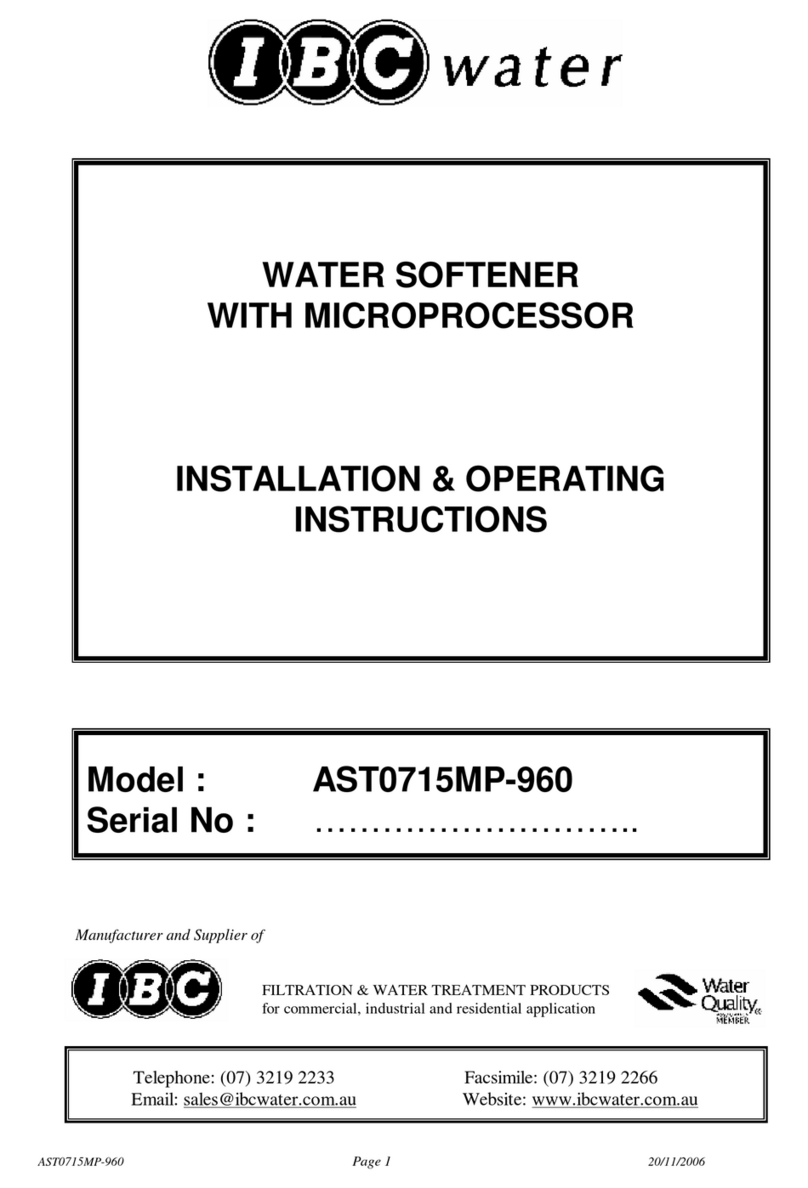
IBC Water
IBC Water AST0715MP-960 Installation & operating instructions
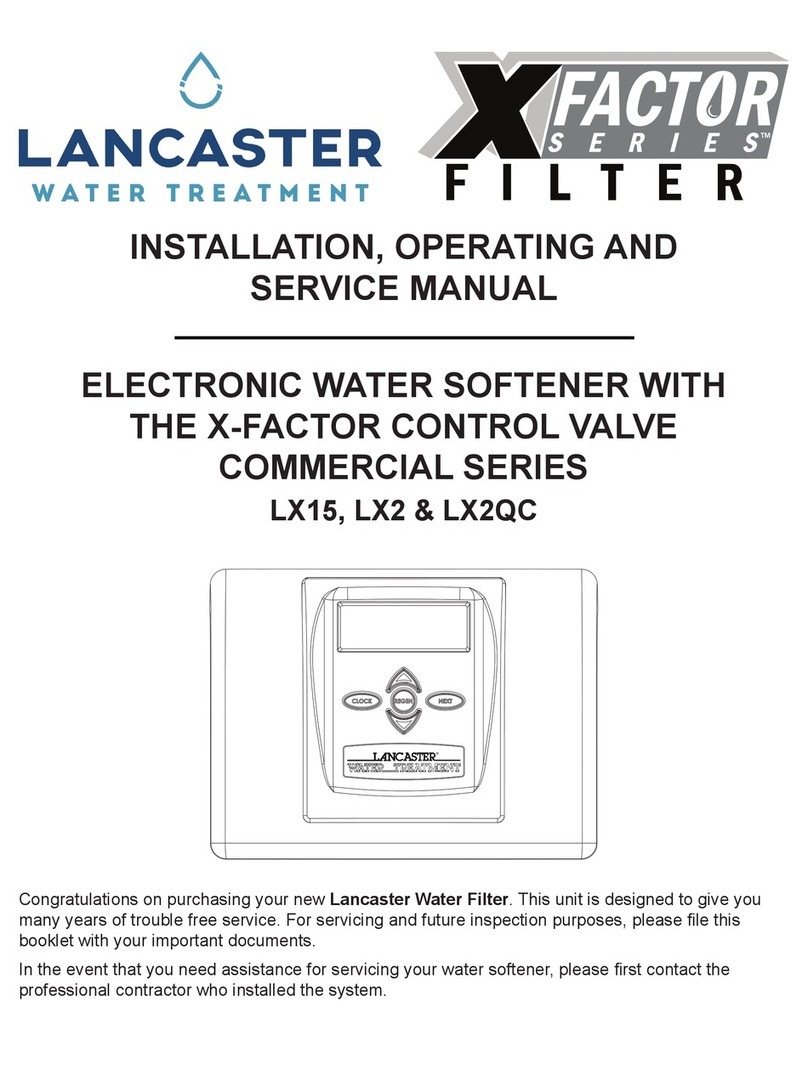
Lancaster Water Treatment
Lancaster Water Treatment X FACTOR LX15 Series Installation, operating and service manual
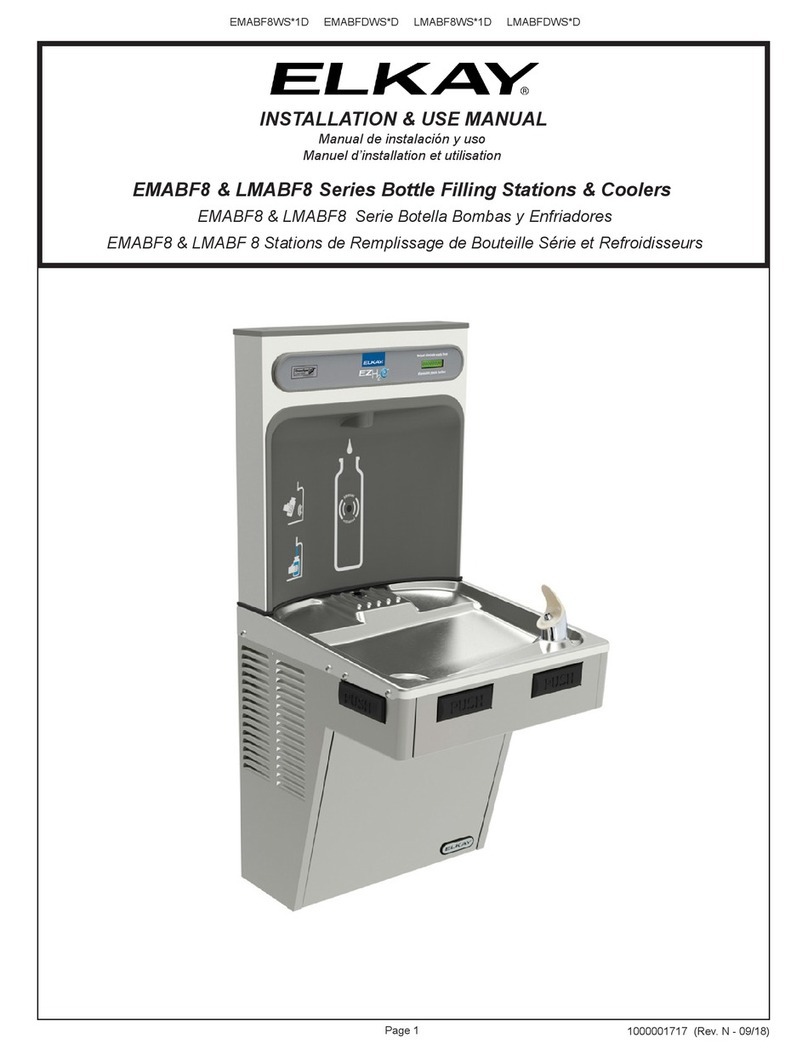
Elkay
Elkay EMABF8 Series Installation & use manual
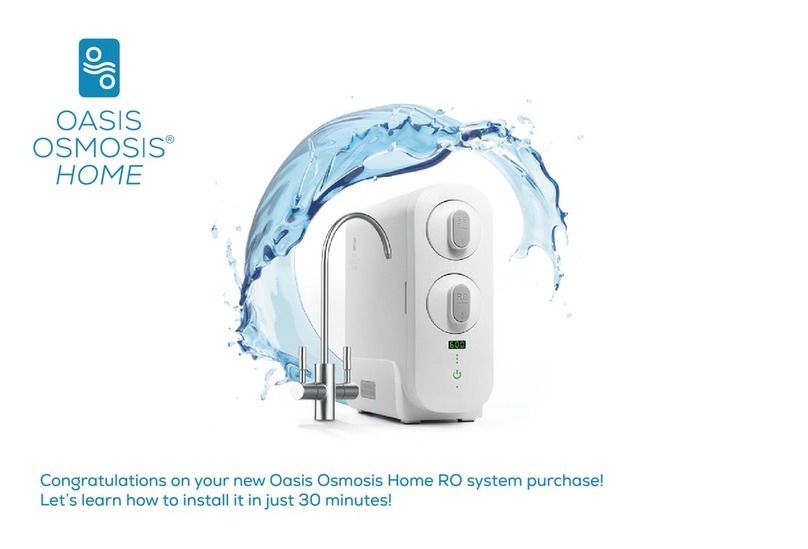
Oasis
Oasis Osmosis Home installation manual

Monarch Water
Monarch Water ULTIMATE MINI AQUA HE install guide
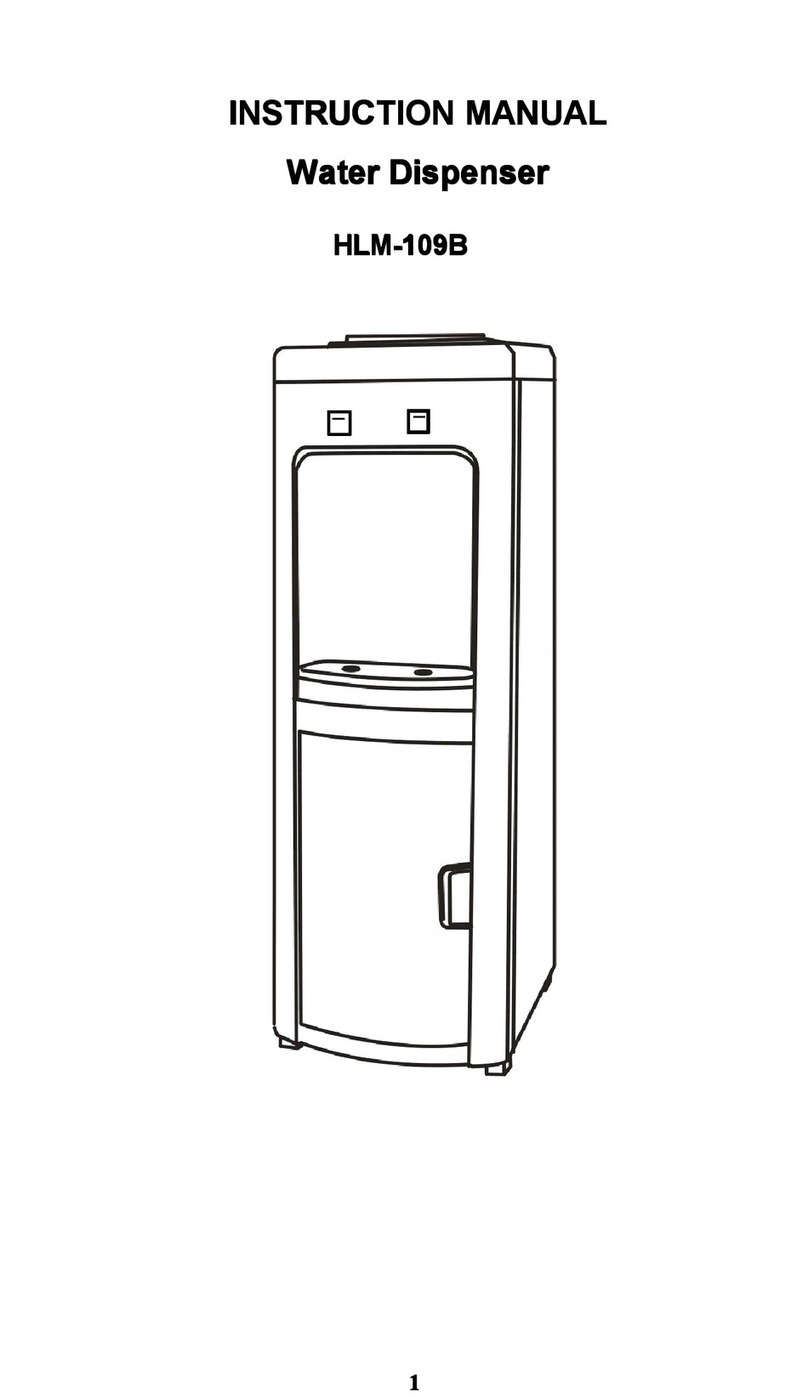
Haier
Haier HLM-109B instruction manual



